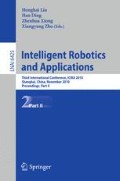Abstract
This paper proposed an adaptive control strategy based on RBF (radial basis function) neural network and PD Computed-Torque algorithm for precise tracking of a predefined trajectory. This control strategy can not only give a small tracking error, but also have a good robustness to the modeling errors of the robot dynamics equation and also to the system friction. With this control algorithm, the robot can work in assist-as-needed mode by detecting the human active joint torque. At last, a simulation result using matlab simulink is given to illustrate the effectiveness of our control strategy.
Access this chapter
Tax calculation will be finalised at checkout
Purchases are for personal use only
Preview
Unable to display preview. Download preview PDF.
References
Lotze, M., Braun, C., Birbaumer, N., Anders, S., Cohen, L.G.: Motor learning elcited by voluntary. Brain 126, 866–872 (2003)
Schoone, M., van Os, P., Campagne, A.: Robot-mediated Active Rehabilitation (ACRE) A user trial. In: IEEE 10th international confercence on rehabilitation robotics, pp. 477–481 (2007)
Pohl, M., Werner, C., Holzgraefe, M., Kroczek, G., Mehrholz, J., Wingendorf, I., Holig, G., Koch, R., Hesse, S.: Repetitive locomotor training and physiotheraphy improve walking and basic activities of daily living after stroke: a single-blind, randomized multicentretrial (DEutsche GAngtrainerStudie, DEGAS). Clinical Rehabilitation 21, 17–27 (2007)
Hasan, M.K., Park, S.-H., Seo, S.-J., Sohn, D.-H., Hwang, S.-H., Khang, G.: A Gait Rehabilitation and Training System based on Task Specific Repetitive Approach. In: IEEE 3rd international conference on bioinformatics and biomedical engineering, pp. 1–4 (2009)
Yang, Q., Siemionow, V., Yao, W., Sahgal, V., Yue, G.H.: Single-trial EEG-EMG coherence analysis reveals muscle fatigue-related progressive alterations in corticomuscular coupling. IEEE transactions on neural systems and rehabilitation engineering 18(2), 97–106 (2010)
Hincapie, J.G., Kirsch, R.F.: Feasibility of EMG based neural network chontroller for an upper extremity neuroprosthesis. IEEE transactions on neural systems and rehabilitation engineering 17(1), 80–90 (2009)
Lunenburger, L., Colombo, G., Riener, R., Dietz, V.: Biofeedback in gait training with the robotic orthosis locomat. In: The 26th Annual International conference of the IEEE EMBS, vol. 7, pp. 4888–4891 (2004)
Den, A., Moughamir, S., Afilal, L., Zaytoon, J.: Control system design of a 3-dof upper limbs rehabilitation. Computer methods and programs in biomedicine 89, 202–214 (2007)
Jezernik, S., Scharer, R., Colombo, G., Morari, M.: Adaptive robotic rehabilitation of locomation: a clinical study in spinally injured individuals. Spinal cord 41, 657–666 (2003)
Morita, Y., Hirose, A., Uno, T., Uchida, M., Ukai, H., Matsui, N.: Development of rehabilitation training support system using 3D force display robot. Springer, Heidelberg (2007)
Lewis, F.L., Dawson, D.M., Abdallah, C.T.: Robot manipulator control theory and practice. Marcel Dekker, Inc., New York (2004)
Park, J., Sandberg, I.W.: Universal approximation using radial-basis-function networks. Neural Computation 3, 246–257 (1991)
Mark, D.L., Hylton, B.M., Victor, S.F., Stephen, R.L.: Walking speed, cadence and step length are selected to optimize the stability of head and pelvis accelerations. Experimental Brain Research 184(2), 201–209 (2008)
Author information
Authors and Affiliations
Editor information
Editors and Affiliations
Rights and permissions
Copyright information
© 2010 Springer-Verlag Berlin Heidelberg
About this paper
Cite this paper
Zhang, F. et al. (2010). An Adaptive RBF Neural Network Control Strategy for Lower Limb Rehabilitation Robot. In: Liu, H., Ding, H., Xiong, Z., Zhu, X. (eds) Intelligent Robotics and Applications. ICIRA 2010. Lecture Notes in Computer Science(), vol 6425. Springer, Berlin, Heidelberg. https://doi.org/10.1007/978-3-642-16587-0_39
Download citation
DOI: https://doi.org/10.1007/978-3-642-16587-0_39
Publisher Name: Springer, Berlin, Heidelberg
Print ISBN: 978-3-642-16586-3
Online ISBN: 978-3-642-16587-0
eBook Packages: Computer ScienceComputer Science (R0)

